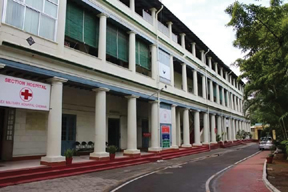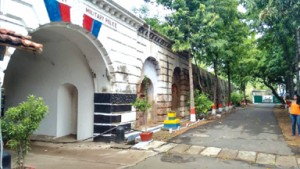Registered with the Registrar of Newspapers for India under R.N.I 53640/91
Vol. XXV No. 11, September 16-30, 2015
Know your Fort better

The ECHS Hospital (Picture: Ramakrishnan Mohan)..
We have in the last two episodes focussed on two principal buildings on Charles Street – the Great aka Admiralty aka Clive House and Wellesley House. This extremely broad thoroughfare has very few buildings on it today. Between Clive’s and Wellesley’s houses is a large edifice belonging to the army and accessed through an arched gateway. This must have in its time been an important building. On the opposite, i.e. the eastern, side runs a long colonnaded building for most of the street’s length. This is today the Ex-Servicemen’s Contributory Health Service (ECHS) Centre of the Fort, but in its long years of existence has served several functions, most notable of which is that of the Town Hall for Madras. This was where the important residents of the Fort met to discuss and decide on important matters concerning the city. But this was not the only building to serve this role in the Fort. It was also till recently the embarkation headquarters for the Southern Command of the Indian Army.
Charles Street ends at the San Thome Gate of the Fort, an arched structure with alternating bands of white and black. This is today closed to the public but gets its name from the fact that it is the southern entrance to the Fort, the pathway from it leading along the sea to the once Portuguese settlement on San Thomè. In its time it must have been a busy thoroughfare with much comings and goings between the two settlements, of which, of course, San Thomè was the older and bigger. But by the time Fort St. George began growing, this once prosperous Portuguese settlement had seen better days and many of its residents began moving into the British town where they settled at the northern end, a place that came to be called Portuguese Square and which we shall deal with in detail later. Others commuted from San Thomè every day to work in the Fort or visit relatives. This influx of people must have happened via the San Thomé Gate.
Today there may be only so many visible reminders of the historicity of Charles Street, but in its time this was a very busy thoroughfare. While we wander along it, it may be worthwhile to pause a while and reflect on the various buildings that do not exist. But before that the broad width of the street also has a history. This was once two parallel streets running north to south, from Parade Square to the San Thomé Gate. The western one was Charles Street and its eastern counterpart was James Street. These, and the easternmost street of the Fort, named after St Thomas, were all connected at the northern end by the church of St Mary’s and at the southern end by road across which lay San Thomé Gate. Sometime in the 18th Century, James Street vanished – the buildings that separated it from Charles Street were demolished and the two roads became one broad thoroughfare – known in early years as Charles and James Street and, then, just Charles Street. Perhaps this was an early instance of renaming streets, something our city specialises in – in the early 18th Century, King Charles II was revered in public memory but not his successor King James II, who had been deposed in a bloodless coup in 1688!
In the early years, when the Fort was nothing more than the present area occupied by the Assembly and Secretariat, Charles Street had the Elambore River flowing along its western periphery. Difficult though it may now be to believe, there was once a river wharf on this street, with eight small guns mounted on it. This was constructed in 1740, following a petition by the street’s residents. The river not being perennial “left shallow grounds,” they said and added, “low swamps which, by the heat of the sun, became a nuisance to the Town. Your petitioners, at very great expense and trouble, have effectually prevented and remedied these mischiefs by building a Wharf Wall upon a foundation of brick wells and filled up with lime stones and other materials for cement. Your petitioners have also faced the said Wharf Wall with Iron Stone, and raised thereon Brick Pallisades, to the great Ornamentation of the River and Beautifying the Prospect of the Town.”
Today, not a trace of the river or the wall survives. Also not traceable are several prominent landmarks that keep surfacing in Company records. The most curious is ‘A Statue of the Goddess of Commerce’ which was set up in a rectangle between Charles and James Streets. It appears to have been there in 1734 and vanished by the 1750s, most probably brought down by the French. The principal cloth godowns of the Company were also on Charles Street, the one at the corner belonging to Thambu Chetty. Another dubash who owned a godown here was Tepperumal Chetty. These buildings were organised by function and bore names such as Calico or Sorting Godown, the Embaling godown and the Import Warehouse. Missing today is also Jearsey House, a stately residence with a long history. Built in the 1640s by Agent Greenhill and used as his residence, this was in 1699 acquired by the Company for its Calico Beating Godown and Granary. By then, it had passed through several hands. William Jearsey had bought it from Greenhill and enlarged it. A consortium of which Elihu Yale was a member later owned this building. In 1692, Sir John Goldsborough arrived in Madras to investigate charges against Yale. He was sworn in as President in Council (the equivalent of Governor), and eight months later, after a full investigation, exonerated Yale. He then embarked on a tour of Cuddalore and Bengal, leaving his wife and children as tenants of Jearsey House. Six months later he was dead and his family moved out. By the 1710s, the building had become a Charity School. All we know of this house today is that it stood close to the ‘Great House on Charles Street’.
Among the most important residents of Charles Street was the Nawab of Arcot himself. In 1758, shortly before the French unsuccessfully laid siege to Madras, Muhammad Ali Wallajah petitioned his friend and Governor, Pigot, for a house in White Town, where he might “lay in a stock of provisions and himself retire thither in case of necessity.” The house assigned to him was at the southern corner of Charles Street, once occupied by a Dr. Munro. On the approach of the French in December that year, Wallajah shifted in and remained there for some time. By the 1770s, with Fort House being in a deplorable condition, Du Pre, the Governor of Madras, shifted to Charles Street, as did his successor Rumbold.

San Thome Gate (Picture: Mukund Vedapudi)..
On the same side as the ‘Great House’, but shown as standing further south of it, which means it stood where Parade Square is today, was another stately building. This was by the 1790s owned by Andrew Ross, Secretary to the Government. With its front on Charles Street and its rear on Palace Street, it was described as having ‘offices, the accommodation of a family, and large spaces of Ground (all of which open into the Back Street where the Arsenal stands, as well as into the street in Front)’ and was offered on rent of 80 pagodas a month for housing the new Courts of Justice. This office later moved to the Choultry Gate Street, which then came to be known as Court House Street.
Standing on Charles Street today, all this hustle and bustle can only be imagined. But in its peace and quiet, we can easily conjure the procession that went down it on July 24, 1727, to the accompaniment of “civic authorities, a foot company and with all English musick.” This was to celebrate the firman of the Mughal Emperor Farrukhsiyar granting the English the continued use of Madras.
-Sriram V

